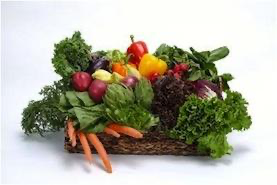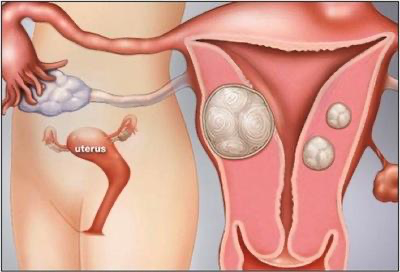Fibroids are benign growths that often build on uterine walls. According to the U.S. Department of Health and Human Services, many women develop uterine fibroids by age 50. Symptoms of fibroid growth include heavy menstrual bleeding, enlargement of the lower abdomen, lower back pain, and painful sex. The cause of these growths is unknown; however, the illness may run in families. Hormone levels, specifically oestrogen and progesterone, control the size and origin of the fibroids. One risk factor for uterine fibroids is diet and weight. A healthy lifestyle that includes a change in eating habits may be one way to prevent or shrink growths.
Fibroid tumors are composed of renegade muscle cells that come together to form a fibrous “knot” or “mass” within the uterus. Although all uterine fibroids are the same, they are categorized based on their location:
- Submucosal fibroids are located just under the uterine lining.
- Intramural fibroids lie between the muscles of the uterine wall.
- Subserol fibroids extend from the uterine wall into the pelvic cavity.
Fibroids most commonly occur between ages 30 and 40, with black women at greatest risk. There has been research indicating that fibroids sometimes run in families.
For some women, fibroids cause no symptoms, but when they do, doctors say problems often involve heavy menstrual periods and prolonged bleeding.
“They can also cause pelvic or abdominal pain or swelling and increased urination,” says Aydin Arici, MD, professor of obstetrics and gynecology and director of reproductive endocrinology and infertility at the Yale University School of Medicine.
Avoiding birth control pills can help prevent fibroid growth. Just as these tumors grow faster during pregnancy, their growth is also accelerated by birth control pills containing oestrogen. Pesticides and herbicides used on food products are also oestrogen-mimicking products to avoid. Tampons and napkins bleached with chlorine can also mimic oestrogen.
Remedies which may be effective in shrinking or eliminating fibroid tumours, as well as alleviating discomfort and symptoms, include:


- Consuming at least three servings of whole grains and/or beans daily. Whole grain and beans also protect against breast and endometrial cancer.
- Eliminating excess oestrogen: using dandelion, milk thistle, and yellow dock help to metabolize oestrogen from the body.
TREATMENT OPTIONS: WHAT YOU SHOULD KNOW
In the not-too-distant past, doctors routinely performed a hysterectomy for fibroid tumors. And while newer, less-invasive treatments are available; studies show this dramatic operation is still being performed today, far more frequently than necessary.
It’s important to recognize that not all hysterectomies are alike. For example, the supra cervical hysterectomy, could still hold the answer for some women. Why? In this type of surgery, you remove only the uterine cavity holding the fibroids and you do not touch the tubes, ovaries, cervix, or vagina, or any of the support muscles in the bladder or pelvis. This means you don’t suffer any of the consequences linked to a traditional hysterectomy, including bladder and sexual dysfunction, or instant menopause.
NATURAL REMEDIES: WHAT YOU SHOULD KNOW
Chasteberry tincture is often used successfully to shrink and prevent the return of fibroids. It reduces excess oestrogen, balances hormones, and reduces inflammation. However, results often only become apparent after several months of usage. The dosage is 25 to 30 drops two to four times a day.
Additional herbs effective in treating fibroids include black cohosh, Siberian ginseng, red clover, goldenseal, red raspberry, licorice root, dong quai, and motherwort. Supplemental oleander extract, primarily used in addressing cancer and HIV/AIDS, is also often effective against fibroids and other types of tumours and irregular cells. Liver cleanses and drinking plenty of water to expel toxins from the body may also be very helpful.
Warm castor oil packs placed on the stomach is another effective method of shrinking fibroids and relieving pain. Ginger compresses are also effective. Taking a variety of digestive enzymes in quantity several times a day on an empty stomach has been reported to be very effective at removing fibroid tissue. For more information see:
Source: http://www.naturalnews.com/028285_enzymes_scars.html ,
http://www.naturalnews.com/029820_fibroid_tumors_shrink.html#ixzz2KbEjxA5u
OTHER MEASURES YOU CAN TAKE
Step 1
Eliminate or reduce the quantities of red meat and pork/ham in your diet. According to the U.S. Health Department website Women’s Health, consuming these animal products puts you at a higher risk for the development of fibroids.
Step 2
Increase the amount of green vegetables you eat. Vegetables may include lettuce, broccoli, cabbage, green beans, Brussels sprouts, or spinach. Eat a salad before each meal, and add at least one green vegetable to both lunch and dinner. Use the colour as your key: Any green vegetable has the potential to protect you from developing fibroids.
Raw fruits and vegetables are not only rich in fibre, they also contain digestive enzymes that remove fibrin. Fibrin, red blood cells, and muscle cells are the components of fibroids. Women suffering from fibroids should consume a healthy diet of five to seven servings of fruits and vegetables per day. Foods like pineapples and citrus fruits, also help block the production of oestrogen. A decrease in oestrogen levels can have a positive effect on fibroid symptoms and growth.
Step 3
Lose weight if you are obese. Create meal plans that decrease your calorie intake. Exercise helps the body to free itself of toxins and regulate ovulation. Some women experience tumour reduction while following a vigorous exercise program.
Step 4
Add whole grains, bran, and other high-fibre foods to your meals. One side effect of fibroids may be constipation; additional fibre may help eliminate this problem. Foods with a high fibre content can help reduce the size of fibroids and relieve symptoms. Fiber helps the liver process and excrete leftover oestrogen from the body. Beans, nuts, and whole grains are examples of high-fibre foods. According to the Linus Pauling Institute, whole grains include compounds called lignans that offer added benefits. Lignans are considered anti-oestrogenic because they interfere with the production of oestrogen. Whole grain foods that are high in lignans include flaxseed, wheat, and buckwheat.
Step 5
Drink plenty of water daily. Monitor your water intake to ensure you drink at least eight glasses every day.
Garlic and Onions
Garlic and onions are high in antioxidants and have natural anti-inflammatory properties. In addition to boosting immunity and being a natural antibiotic, garlic also inhibits the growth of tumours. It is best to eat it raw, as cooking destroys some of its nutrients.
Nuts and seeds
Almonds, walnuts, sunflower seeds, and especially Brazil nuts are all excellent sources of fatty acids and a great source of protein. Brazil nuts contain selenium which is good for encouraging a healthy uterine lining. Include five to 10 Brazil nuts in your diet every day.
MEDICAL DISCLAIMER
The information given here is for educational purposes only. It is meant to be used as a guide towards health and does not replace the evaluation by and advice of a qualified licensed health care professional.
Source: lhfministries.org

